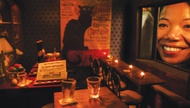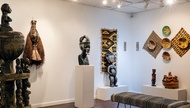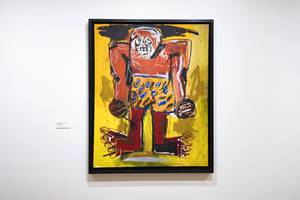
Michael Heizer Through August 12, Monday-Friday, 9 a.m.–5 p.m. MCQ Fine Art Advisory, 620 S. 7th St., 702-366-9339.
Think Michael Heizer. Think Nevada and the desert landscapes from which his internationally renowned art works source their power. Near Overton, Heizer’s “Double Negative”—a lodestar in the Land Art movement—spans a canyon, rutting through 1,500 feet of mesa on either side and displacing 244,000 tons of rock in the process. In Garden Valley, near Hiko, Heizer is completing “City,” a monumental sculptural complex worthy of pharaohs—the footprint is a colossal 1.25 miles long, a quarter mile wide and more than four decades in the making. Masterpieces on this scale aren’t designed for urban centers, much less galleries or museums: only the remote, wide-open spaces of the Southwest could frame them.
Which makes Michael Heizer at MCQ Fine Art all the more intriguing. The small, choice show of prints suggests that the crotchety artist who famously renounced the art market—rejecting sellable objects for impervious acreage—has a softer side, scarcity of inventory notwithstanding. The seven drypoints, screenprints, lithograph and etchings on display engage familiar Heizer content (line, shape and mass), but reveal a jaunty freedom massive earthworks could never incorporate. Heizer’s maniacal exactitude is everywhere, but tamed by a gestural lyricism that only the artist’s hand, not a bulldozer, can supply.
Two knockout screenprints, “Post Historic Screenprint No 1” and “No 2,” feel almost animistic. Completed in 2014, the 46-by-46-inch works feature a tribal palette, nervy graffiti and images of stones seemingly vibrating right out of the picture plane. The uncanny perspective derives, partly, from the 23 passes, seven screens and up to 23 colors in the printing process, coupled with a 14-year compositional gestation. While the stones appear to be scaled down from sculptural studies, Heizer actually did the opposite: scaled-up small prehistoric tools, monumentalizing their mass and dramatizing their presence. Multiple contour lines create auras, transforming fragments of geology into fetishes worthy of a shaman.
Another striking print, “Levitated Mass” (2015), riffs on the 340-ton boulder Heizer permanently installed at LACMA in 2012. Centrally positioned in the 35-by-94-inch lithograph, the boulder bobs amid geometrical currents—gestural lines, crosses and circles tracing their source, in part, to motorcycle-track drawings Heizer inscribed on a dry lake bed near Las Vegas almost 50 years ago. The recent marks made on lithographic stone are loose, carefree. Recalling ley lines, geoglyphs and petroglyphs, they seemingly suspend the boulder in magnetic, gravitational and atomic fields of energy, as if the boulder itself were commandeering forces of nature.
As complements to sculptural projects, Heizer’s prints at MCQ are informative. As graphic works in their own right, they’re revelatory.








